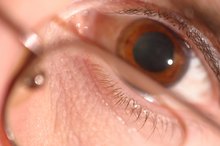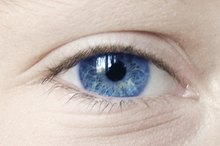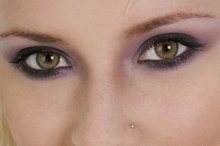The pupils are the black circles, or openings, in the middle of the eyes that allow light to penetrate the eyes. This light is then sensed by light-sensitive cells in the back of the eyes. Pupil dilation is when the size of the pupils increase; the ring of color around the pupils, called the iris, is actually a muscle tissue that expands and contracts to change the size of the pupils to allow more or less light into the eyes.
If you are experiencing serious medical symptoms, seek emergency treatment immediately.
Light: Natural Cause of Pupil Dilation
The main reason pupils dilate is to assist with vision in dark areas 1. Typically, when you are in a well-lit area, the pupils are very small because there is adequate light reaching the eye. When you step into a dark room, the eyes dilate to allow more light into the eye to provide as clear an image as possible to the brain. You have probably experienced the feeling of the indoors seeming very dark after coming inside during a sunny day. This is because it takes the eyes a little while to dilate and adjust to the reduced lighting.
- The main reason pupils dilate is to assist with vision in dark areas 1.
- When you step into a dark room, the eyes dilate to allow more light into the eye to provide as clear an image as possible to the brain.
Mydriatics: Testing the Pupils for Dilation
Dilated Eyes When Exercising
Learn More
Mydriatics are medicinal eye drops that cause the eye to dilate. When you get an eye exam, a doctor or technician may use mydriatics to dilate the eyes to better observe them and their response to light. Because the medicine forces eyes to dilate, you may have to wear sunglasses for an hour or so after your exam before your eyes recover; looking around in bright conditions with fully dilated eyes can overwhelm the eyes and cause eye damage.
Drug Use As Causes of Pupil Dilation
Many types of drugs, both legal and illegal, can cause the eyes to dilate. Hallucinogenic drugs such as LSD and mushrooms are known to cause pupil dilation, as are many other substances such as cocaine, marijuana, ecstasy and crystal meth. Prescription antidepressants are also known to cause dilation in the eyes.
- Many types of drugs, both legal and illegal, can cause the eyes to dilate.
- Hallucinogenic drugs such as LSD and mushrooms are known to cause pupil dilation, as are many other substances such as cocaine, marijuana, ecstasy and crystal meth.
Poison: Cause of Pupil Dilation
How Can Eye Color Change With Mood?
Learn More
Pupil dilation is a common response to being poisoned by different kinds of plants and chemical poisons. The black locust tree has bark that can cause poisoning that leads to pupil dilation. Many toxic chemicals such as chloroform and jet fuel will cause pupil dilation if accidentally ingested.
Arousal & Pupil Dilation
Because the nervous system controls the muscles of the irises, the response of the nervous system to different stimuli results in involuntary pupil dilation. Another commonly cited reason the pupils dilate is in response to excitement or sexual arousal. When a person sees something or someone he finds very attractive, his eyes may dilate.
Related Articles
References
- Wrong Diagnosis: Dilated Pupils
- Aguirre GK. A model of the entrance pupil of the human eye. Sci Rep. 2019;9(1):9360. doi:10.1038/s41598-019-45827-3
- Bloom J, Motlagh M, Czyz CN. Anatomy, head and neck, eye iris sphincter muscle. StatPearls. Updated June 6, 2019.
- Mathôt S, Fabius J, Van Heusden E, Van der Stigchel S. Safe and sensible preprocessing and baseline correction of pupil-size data. Behav Res Methods. 2018;50(1):94–106. doi:10.3758/s13428-017-1007-2
- Payne WN, Barrett MJ. Anisocoria. StatPearls. Updated June 3, 2019.
- LaRoche MJ. Anisocoria and an array of neurologic symptoms in an adult with Ewing sarcoma. J Adv Pract Oncol. 2017;8(1):18–23. doi:10.6004/jadpro.2017.8.1.2
- InformedHealth.org [Internet]. Cologne, Germany: Institute for Quality and Efficiency in Health Care (IQWiG); 2006-. What kinds of eye examinations are there? 2016 Apr 20 [Updated 2016 Apr 20]. Available from: https://www.ncbi.nlm.nih.gov/books/NBK367578/
- McDougal DH, Gamlin PD. Autonomic control of the eye. Compr Physiol. 2015;5(1):439–473. doi:10.1002/cphy.c140014
- Lykstad J, Hanna A. Neuroanatomy, pupillary dilation pathway. StatPearls. Updated December 9, 2018.
- Doran M, Karmel M, Stuart A. 4 Neuro Conditions Not to Be Missed. American Academy of Ophthalmology. EyeNet Magazine. June 2012 aao.org
- Park JW, Kang BH, Kwon JW, Cho KJ. Analysis of various factors affecting pupil size in patients with glaucoma. BMC Ophthalmol. 2017;17(1):168. doi:10.1186/s12886-017-0564-6
- Kang SD. Ruptured anterior communicating artery aneurysm causing bilateral oculomotor nerve palsy: a case report. J Korean Med Sci. 2007;22(1):173–176. doi:10.3346/jkms.2007.22.1.173
- Liu SL, Nie YH, He T, Yan XX, Xing YQ. Iris metastasis as the first sign of small cell lung cancer: A case report. Oncol Lett. 2017;13(3):1547–1552. doi:10.3892/ol.2017.5648
- Micieli G, Magri M, Sandrini G, Tassorelli C, Nappi G. Pupil responsiveness in cluster headache: a dynamic TV pupillometric evaluation. Cephalalgia. 1988;8(3):193-201.
- Chen JW, Gombart ZJ, Rogers S, Gardiner SK, Cecil S, Bullock RM. Pupillary reactivity as an early indicator of increased intracranial pressure: The introduction of the Neurological Pupil index. Surg Neurol Int. 2011;2:82. doi:10.4103/2152-7806.82248
- Dichter SL, Shubert GS. Argyll Robertson Pupil. [Updated 2019 Nov 6]. In: StatPearls [Internet]. Treasure Island (FL): StatPearls Publishing; 2019 Jan-. Available from: https://www.ncbi.nlm.nih.gov/books/NBK537179/
- Peragallo J, Biousse V, Newman NJ. Ocular manifestations of drug and alcohol abuse. Curr Opin Ophthalmol. 2013;24(6):566–573. doi:10.1097/ICU.0b013e3283654db2
- Schallhorn SC, Kaupp SE, Tanzer DJ, Tidwell J, Laurent J, Bourque LB. Pupil size and quality of vision after LASIK. Ophthalmology. 2003;110(8):1606-14.
- Doran M, Karmel M, Stuart A. 4 neuro conditions not to be missed. American Academy of Ophthalmology. 2012.
- Liu GT, Volpe N, Galetta SL. Neuro-Opthalmology: Diagnosis and Management. 2nd ed. Amsterdam, Netherlands: Elsevier Health Sciences; 2010.
Writer Bio
Gregory Hamel has been a writer since September 2008 and has also authored three novels. He has a Bachelor of Arts in economics from St. Olaf College. Hamel maintains a blog focused on massive open online courses and computer programming.








